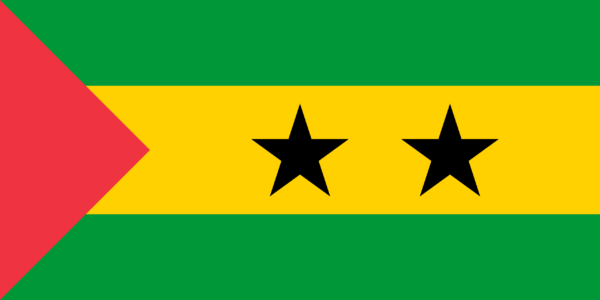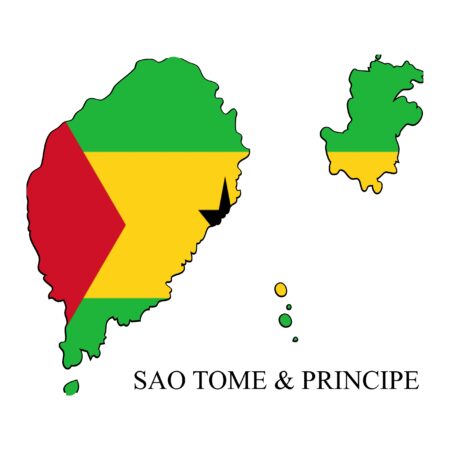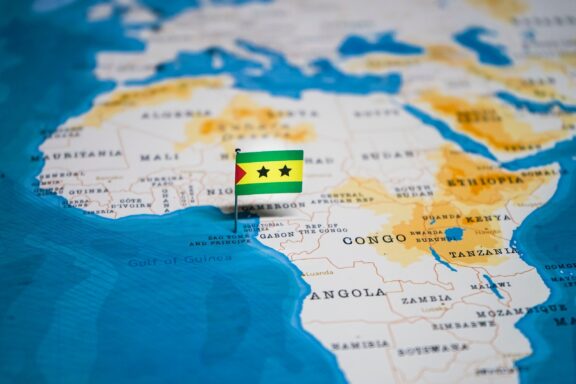National flags symbolize a country’s identity, representing its history and culture. Each design element, from the colors to the shapes and emblems, often carries specific meanings that offer insights into the nation it represents. Regarding São Tomé and Príncipe, the flag is no exception.
São Tomé and Príncipe Flag

São Tomé and Príncipe Flag: Color Palette
São Tomé and Príncipe Flag Flag Emoji: 🇸🇹
The flag of São Tomé and Príncipe has unique design features with specific symbolism. The flag has horizontal stripes and a red triangle, each conveying a particular meaning.
The flag’s design elements contribute to a richer understanding of the nation’s history, economy, and natural beauty. Looking at the flag, one can understand what São Tomé and Príncipe values as a country, making it an emblem of national unity and pride.
Meaning of Each Color

Green
The prominence of green mirrors the lush landscapes of São Tomé and Príncipe and echoes broader cultural beliefs around fertility and prosperity.
In various African traditions, green is seen as a color of life and renewal, aligning with local reverence for the natural world. The choice of green also reflects a recognition of the importance of environmental preservation, considering the country’s wealth of biodiversity.
Yellow
Beyond its immediate symbolism of sunshine and the cocoa industry, yellow has cultural connotations of optimism and happiness.
Historically, yellow was a color often associated with trade and commerce, which makes sense for a nation where cocoa and other exports have been a critical part of its development.
In global contexts, yellow is sometimes linked to enlightenment and wisdom, which align with the nation’s forward-looking attitude.
Black
Black is a color that often signifies strength, power, and authority. In the context of São Tomé and Príncipe, where it appears in the Coat of Arms, black could be interpreted to represent the resilience and fortitude of the people.
Historically, black has been a color used to symbolize the African diaspora and the collective experiences and struggles of people of African descent.
Red
While red is commonly associated with courage and valor, it can also represent emotional intensity and passion.
Regarding São Tomé and Príncipe, the red triangle evokes a sense of urgency and significant change in the country’s tumultuous journey toward independence.
Red is also a color with deep roots in many African cultures, frequently associated with earth and groundedness, providing another layer of interpretation.
São Tomé and Príncipe Coat of Arms
While São Tomé and Príncipe’s flag doesn’t incorporate its Coat of Arms, both symbols share thematic elements that underline the nation’s identity. If they were to be displayed together, the Coat of Arms would offer a more detailed representation of the country’s geography, history, and culture.
The absence of the Coat of Arms on the flag allows for a simpler and more streamlined design, making it easily recognizable at a distance.
Historical Evolution and the Meaning Behind Changes
The flag of São Tomé and Príncipe has its roots in the era of independence. Before becoming an independent nation on July 12, 1975, the islands were a colony of Portugal.
The flag was entirely different during the colonial period, representing Portuguese governance. The current flag was adopted upon the declaration of independence and was designed to encapsulate the aspirations and identity of the new nation.
The flag has seen no significant changes since its inception, indicating a strong resonance with its initial symbolism. The enduring nature of these elements suggests that they continue to hold relevance in shaping the nation’s self-image.
The lack of changes to the flag’s design may indicate that its original symbolism remains relevant to the country’s self-image and aspirations. It is a constant visual reminder of the critical merits at the inception of São Tomé and Príncipe as independent nation.
The historical evolution of São Tomé and Príncipe’s flag is characterized more by its stability than by any radical changes. This stability can be interpreted as a testament to the nation’s enduring importance and unique attributes.
Overall Symbolic Meaning of the Flag

The flag of São Tomé and Príncipe serves as a visual narrative that combines various aspects of the nation into a cohesive whole. While each color on the flag carries its distinct symbolism, when viewed together, they form a unified message about the country’s interconnectedness between nature, economic vitality, and the spirit of independence.
This harmonious blend captures the essence of a nation that values its natural heritage, acknowledges its challenges, and remains hopeful for its future. In this way, the flag is a compact representation of the nation’s complexity and aspirations, encapsulating a multi-layered story in a simple yet profound design.
Read also: Where is São Tomé and Príncipe?
Similar Flags to São Tomé and Príncipe
São Tomé and Príncipe’s flag has unique elements that differentiate it from others; however, it does share specific color schemes with flags of both African and colonial-linked nations, reflecting broader themes of continental unity and historical ties.
Guinea-Bissau
The flag of Guinea-Bissau resembles its color scheme with São Tomé and Príncipe’s flag, specifically in yellow and green.
These colors are commonly used in flags of African nations to signify natural resources and the land. This commonality speaks to shared continental themes rather than direct historical or cultural links between the two nations.
Related: Flag of Guinea-Bissau.
Ethiopia
Ethiopia’s flag uses green, yellow, and red, albeit in a horizontal layout. These colors have influenced the design of many African flags due to their association with the Pan-African movement.
While São Tomé and Príncipe’s flag does not strictly adhere to Pan-African colors, these hues suggest some continental unity or shared ideals.
Related: Flag of Ethiopia.
Portugal
While not similar in design, it’s worth noting that the flag of Portugal may have indirectly influenced the flag of São Tomé and Príncipe due to the colonial history between the two nations.
However, the São Tomé and Príncipe flag deliberately moves away from Portuguese symbolism to forge its identity.
Related: Flag of Ethiopia.
Conclusion
São Tomé and Príncipe’s flag is a multifaceted symbol that succinctly captures the nation’s identity and aspirations. It maintains a unique position within the global community of flags, sharing some elements with other African nations yet remaining distinctly its own.
For the country’s citizens, the flag serves as a unifying emblem that embodies their shared history, values, and hopes for the future. It is a lasting representation of the individual and collective experiences that define this vibrant nation.
Image Sources and Copyright Information
- São Tomé and Príncipe Flag Map: © DegreeStudioMY/Shutterstock
- Flag Pin on São Tomé and Príncipe Map: © hyotographics/Shutterstock